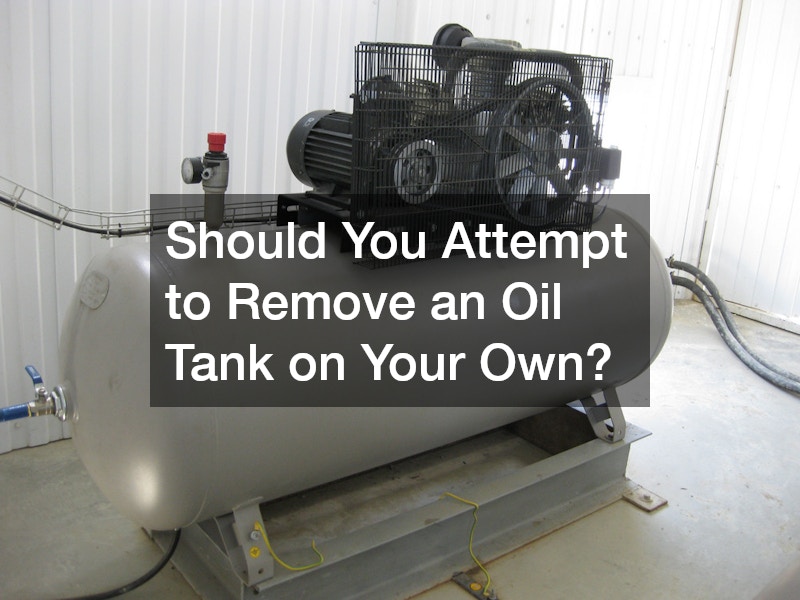Removing an oil tank is a task fraught with potential risks and challenges that can be daunting for the average homeowner. Deciding to tackle this project independently requires a clear understanding of the local regulations, awareness of potential hazards, and a careful evaluation of one’s own capabilities. Hiring professionals often provides a safer and more efficient approach, mitigating many of the associated risks.
What Are the Risks Involved in DIY Oil Tank Removal?
Removing an oil tank without professional help can expose you to significant dangers, such as oil leaks, which can lead to soil contamination and environmental damage. Accidental spills during removal may not only harm the surrounding land but also seep into local water supplies, causing long-term ecological harm.
Aside from environmental concerns, personal safety is a major issue, as handling heavy equipment and hazardous materials without proper training can result in injury.
Even small oversights during tank removal can lead to costly consequences, both financially and environmentally. Proper oil storage and cleanup techniques are essential to avoid mishaps that could otherwise result in hefty fines or environmental liabilities. In addition to the risk of physical injury or contamination, improperly removed tanks can lead to property value deductions and complicate future property sales.
Many homeowners underestimate the intricacies involved in removing an oil tank, mistakenly assuming it to be a simple, straightforward process. Factors such as age, condition of the tank, and surrounding groundwork can significantly complicate the task. For example, older tanks are more prone to leaks and may require specialized handling procedures to avert disaster.
Are There Legal Requirements for Oil Tank Removal?
Before commencing any oil tank removal, it is imperative to become familiar with your area’s legal requirements. Local and federal regulations dictate that appropriate permits and inspections be secured to ensure compliance. These legal safeguards are in place to protect both the environment and individuals involved in the removal process from undue harm.
Failure to adhere to legal protocols can result in severe fines and legal repercussions. Regulations often vary from state to state and locality to locality, making it crucial for individuals to conduct thorough research or seek professional guidance. Such regulations are not merely bureaucratic hurdles but objective measures to uphold safety and environmental standards.
Moreover, understanding the legal landscape of oil tank removal can assist in making informed decisions about the project. Many municipalities require written documentation certifying the tank’s safe removal and disposal. While these may seem like excessive steps, they are essential to maintaining community safety and environmental integrity.
What Tools and Equipment Are Needed?
Attempting to remove an oil tank independently requires a comprehensive toolkit, including both essential tools and protective safety gear. Critical tools include heavy-duty cutting equipment, lifting machinery for handling massive tanks, and containment materials for safely storing residual oil or contaminants. Adequate safety equipment, such as gloves, eyewear, and protective clothing, helps minimize risk.
Utilizing the right resources can significantly improve the handling of unexpected incidents during removal. Resources like spill containment kits, liners, and absorbent materials offer critical backup solutions in the case of accidental leaks. In addition to equipment, accessing up-to-date procedural guides or consulting with professionals on best practices can offer invaluable insights.
Keep in mind that a manageable DIY project is only as successful as the tools and planning applied to it. Accurate measuring tools ensure a proper and safe excavation process. Furthermore, communication devices like two-way radios can enhance coordinated efforts, particularly in more complicated extraction procedures. Don’t underestimate the importance of well-coordinated equipment for a successful endeavor.
When Should You Hire a Professional?

Knowing when to defer to professional expertise in oil tank removal can save you from unforeseen complications. Situations involving particularly aged or deeply buried tanks suggest the need for professional intervention. The proficiency and experience professionals bring to the table can prove invaluable, especially in complex scenarios involving potential contamination or structural removal challenges.
Hiring experts not only relieves you of the technical burdens but also ensures that the project meets the highest safety standards. Professionals are typically insured, which implies that any resultant damage or issues during the process are covered, mitigating your financial risks. Their trained eye can spot potential hazards that might go unnoticed by an untrained individual.
While the initial cost of professional services might seem steep, it pales in comparison to the expenses incurred from potential DIY blunders. Professionals come equipped with specialized equipment and have the requisite permits and certifications to complete the task legally and efficiently. They provide peace of mind that only comes from knowing the job has been done correctly and safely.
Evaluating whether to attempt oil tank removal on your own involves careful consideration of the associated risks, tools required, and legalities involved. While some may opt for a DIY approach, the associated dangers and potential complications make hiring a professional a more prudent choice in many cases. Ensuring compliance with both local and federal regulations, mitigating safety risks, and safeguarding your property – these are all compelling reasons to consider professional expertise for oil tank removal.
